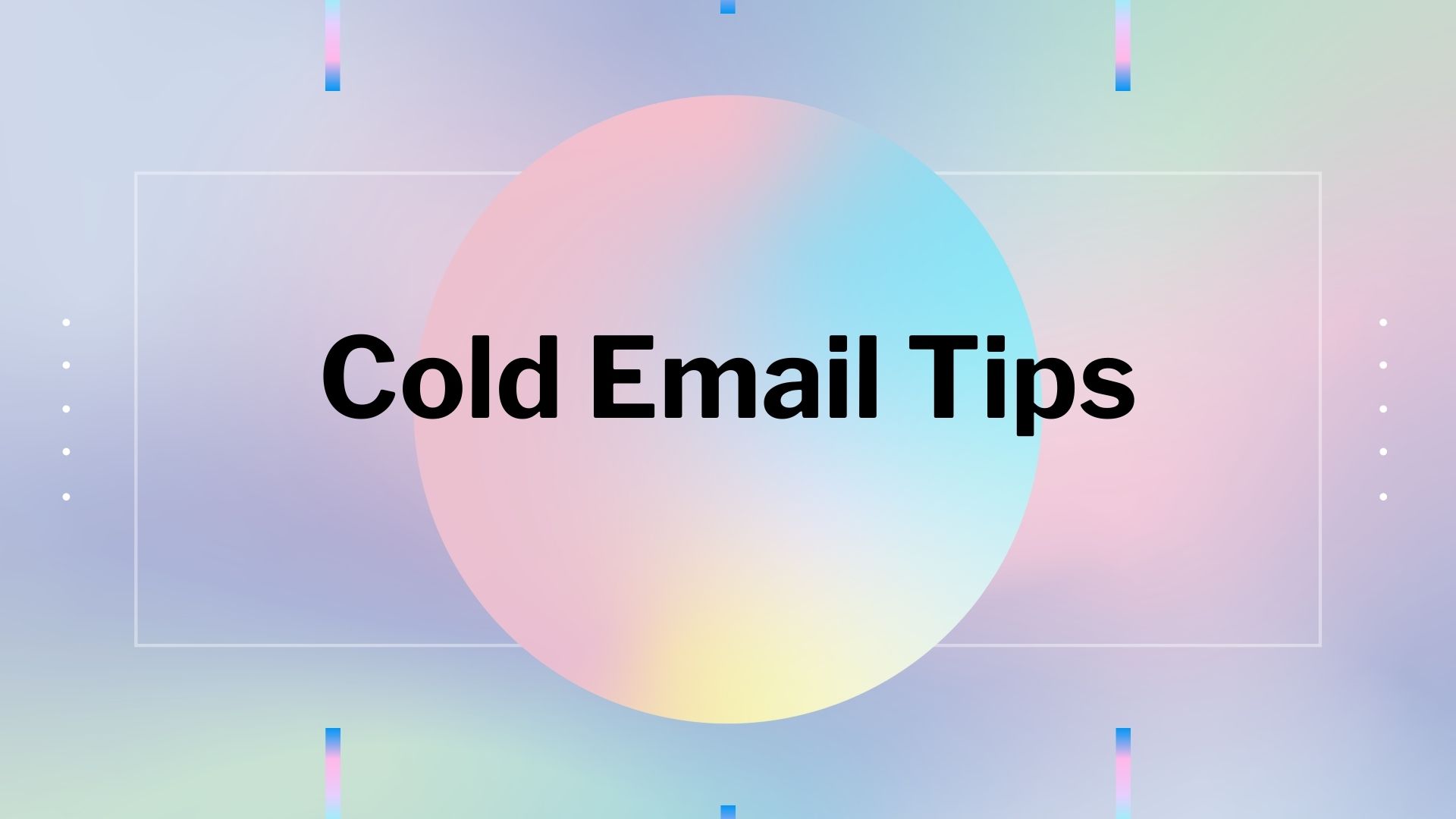I’m a proponent of cold email for startup founders so we put together cold email tips with real examples. You can target exactly who you want and get quick feedback on the effectiveness of your messaging. Unfortunately, today cold email is also used by every sales team, which means your prospects are inundated with such messages. With tools like Salesloft, Zoominfo, and free email finders, it’s easy to send tons of messages. In order to cut through the noise and put yourself in a position to succeed, you’ll want to follow these cold email tips:
Cold Email Tips – Subject Line
- Subject Line – 3 Words or Less
The first thing a recipient of your cold email will see will be the subject line. Studies have shown that subject lines with three words or less perform the best. Your goal with a subject line is to have the recipient open the email. It can also be connected to the body of your email. Don’t overthink it.
I’ve been using [Company name], [Company name’s] department I’m targeting and “my company name” as subject lines.
Example subject lines: Stripe, Stripe’s Marketing Team, and Profs
Your goal with your emails should be to get a 40-60% open rate. Remember to test this. These are mostly tried and true cold email tips but things do change and every industry is different.
Cold Email Tips – The Content
- Personalize the first sentence
After seeing the subject line, the sender’s name (you can’t do much about that besides making sure you have a professional email domain you’re sending from), a prospect will see the preview of your message. You should personalize that sentence. If your recipient is using a browser, typically they will see about ten words, assuming they’re using Gmail. On their mobile phone they’ll see around three words. You do not want to waste this precious email real estate on fluff or introducing yourself. This first sentence needs to get the recipient to read the rest of your email.
When personalizing the first sentence, you’ll want to do about five minutes of research. Look them up on LinkedIn. See if there’s any relevant information. Google them to see if they’re on Twitter, have been featured on any Podcasts, or have been mentioned in the news. Show them that you’ve done a bit of research. Most people do not receive personalized emails. Connect that artfully to the rest of your email.
- Don’t talk about yourself
Founders quickly learn that prospects do not care about their product, where they went to school, what awards they won, or the amazing technology they’re using. Too often they want to tell a prospect how great they are or how great their startup is. Nobody cares. At all. Prospects only care about themselves. They want to know how you benefit them. How you solve their problems. They want to learn something.
- Balance quality with quantity
Cold outreach is a numbers game. No matter how good your email is, some people will never respond. You need to make sure you spend time personalizing for your Tier 1 list, but you also need to make sure you’re sending enough emails and not spending too much time writing them. Try to keep it to 5 minutes of preliminary research and 5 minutes to write a high quality email. The more you do it, the faster you’ll be able to churn out personalized emails that don’t feel formulaic, but also won’t eat up too much of your prospecting time. Templated outreach is fine but you need to make sure your templated messages are relevant to the lists you’re building. Creating templates tailored to job titles or industries is a way to send better messages.
- One pain per email
There’s no need to mention everything your product can do in one email; you should not write emails that mention multiple pains or problems. Pick one pain to focus on per email and stay on topic. You can use follow up emails for other pains you solve for. Make the email about the pain and how it affects your prospect.
- Generate Curiosity, Lead with an Insight, Capitalize on an Insecurity
Often Founders want to tell their prospect everything about their product. They dump an ‘About’ page into the email, but it’s okay to remain a bit mysterious and let your prospect become curious. Fight the urge to overwhelm them with details. If they need more information, they will either ask you or go to your website. Leading with insight is a great way to establish credibility while teaching your prospect something they may not already know. Making your prospect a little insecure may seem challenging or counterintuitive, but an easy way to do that is to ask, “how are you ensuring that x” – x being a problem your product will solve for. An example could look like – “How are you ensuring that your marketing team is generating enough qualified leads?” for a startup that helps marketing teams generate qualified leads.
Cold Email Following Up – One Email Isn’t Enough
- Follow up emails are key
The money is made in the follow up. This is one of the best cold email tips. In my experience, most of my meetings are not booked on my first email. It’s the second email that I’m sending as a follow up where I book most of my meetings. Following up is key for everything sales related. If you’re not following up on cold emails, you’re leaving money on the table. Don’t feel like you’re being pushy by sending a follow up email. If you spent time personalizing the first email, you should have no issue following up. People receive a lot of emails; a follow up email can often be the difference between securing a meeting and getting no response at all. Worst case scenario is the prospect doesn’t reply or tells you that they’re not interested.
- Apples to apples social proof
Social proof was coined by Robert Cialdini in his 1984 book Influence. It’s a psychological and social phenomenon wherein people copy the actions of others in an attempt to undertake behavior in a given situation. When using social proof in cold emails, you need to make an equivalent reference. What that means is if you’re selling to a small business, the social proof should be of another small business. Using a large company as social proof to try to book a meeting with a smaller company will not be effective. Prospects want to know similar companies benefited from your offering. If it’s not an apples to apples comparison, they’ll assume it’s too expensive or the product isn’t built for their particular needs.
- Multiple emails over two or three weeks
Earlier we discussed sequences: You can send multiple emails to prospects over two or three weeks. Although response rates decline with time, you will book meetings on your third, fourth, fifth, and so on, emails.
Cold Email Tips You Must Remember
- Write for mobile
When someone opens an email on their phone, they’re not going to want to scroll. This is one cold email tip is key to remember. Make sure your email fits without requiring someone to scroll. Don’t underestimate the power of using white space! Design your emails so that the readers’ eye naturally looks towards the most important points you want them to take away.
- Keep it short
Cold emails need to get straight to the point. Keep your emails between 3 or 4 sentences. There are times when longer emails are necessary and appropriate, but that will be when you have high value information for personalization.
- Write like you speak
Remove the fluff. You would never say, “Hope all is well” in person when meeting someone. Read your emails aloud. If it sounds rigid, too salesy, or filled with jargon, delete it.
Cold Email Calls To Action
- Soft calls to actions perform well
In the past, you’d ask, “How does 4pm on 12/22 look for a call to discuss x?” Now you want to use what are soft calls to actions like, “Open to learning more?” or “Interested in learning more?” As far as cold email tips go, this one could change over time as more salespeople use it.
- Offer a training session or something of value
An effective way to get in front of prospects is to send an email talking about a topic you know really well. Provide an insight by writing an email where the recipient learns something. It’s even better if you can connect it to their team in some way. Two days later, send a follow up email offering a training session or workshop on that topic at no cost. Let them know there’s no charge or catch. This works because you’re offering something of value with no strings attached. In order for this to work, you’ll need to put together a training or workshop on a topic that lasts about 20-25 minutes. If you put on a good session, you’ll establish yourself as credible and trustworthy. Naturally, prospects will want to know more about you and your startup.
Prospects are not stupid; they know you’re a startup that wants to sell them something. Often, the senior person who scheduled the meeting will ask you about your company at some point during the session, or they’ll thank you and schedule time with you in the future. I know this because I scheduled dozens of high value meetings at my last startup with this approach. I was able to get clients, establish myself as an authority on the topic (that was related to my startup), and build my network. To this day, I still have good relationships with some of the senior leaders at these companies, because I helped them and their team for free. The training session I offered was of high value, and multiple times I was offered $5,000 or more to host another session. You need to put something together of value that people will be willing to pay for. If you can do that, you’ll open up sales conversations with decision makers who will want to help you. Even if they don’t buy from you, you will be building up your network, and they may even refer your business to others.
- Your goal is to book a meeting
One thing a lot of people who are new to cold emailing do is try to sell their product via their cold email. The goal of cold email is to book a meeting. That’s it. You do not need to do more than that. You can read all the other cold email tips but this is something you have to remember when writing your email. This is exactly why you want to create curiosity, pique interest, lead with an insight, and so on. Too many people try to tell the prospect everything at once, and as we’ve already established, this can be overwhelming or seen as disingenuous. In other words, selling in a cold email violates a couple best practices explained above. Remember, your goal is to book a meeting.
Cold Email – Real Message Examples
Below are two LinkedIn messages but you’ll get an idea of how personalization works. It’s no different for LinkedIn. Here’s a prospect’s About section that has some unique information that shows their personality, tells a nice story, and gives you plenty of info to leverage for personalizing outreach.
In my message below, I used “Cerro Negro” as my subject.
It’s immediately clear to the prospect that this is not a templated message. It’s personalized and likely very different from what she normally receives. With a personalized subject line, I’ll have an above average chance to get an open on my message.
Subject lines matter because people get a ton of messages and it’s the first thing they’ll see in their LinkedIn inbox. Don’t overthink the subject line but try to make it stand out. Do not write “Web Development Services for Company X” – That’s so easy to delete and opening that message is going to be a waste of time. You know what’s coming after that. Do your best to create curiosity. Make people want to click to read your message.
Back to the message, below. I was able to personalize my message and connect the value proposition of what my product solves (save time researching prospects to make personalizing outreach easier) to a unique experience that my prospect told the world about on LinkedIn. I connect the struggle she has climbing Cerro Negro with the struggle her salespeople have personalizing outreach. Connecting those two pieces of information is a bit of an art and takes time to get good at. The more you practice doing it, the better you’ll get.
In my message, I have four points of personalization to point out.
- Cerro Negro
- Mentioning the uphill struggle
- Volcanic ash
- Put out some fires
Meeting booked!
When I sent the message, I knew I had a really good shot of getting her to agree to a meeting. The message was highly personalized, creative, succinct, and definitely stands out because most messages on LinkedIn are garbage and email inboxes have tons of templated junk. The bar is low. Remember, if you put in the effort to do a little research and follow best practices, you’ll get meetings.
If you’re inexperienced writing cold messages, you must remember that you do not need to say everything in your message. Your goal is to get a meeting, not tell them everything about your company.
Your prospect doesn’t care about you. And that’s correct. There is an exception. If they make it known that they have a problem or demonstrate interest in something that you specifically solve, you can share a bit more about yourself because it’s fair to assume it’s highly relevant.
Cold Outreach Example
The below example was cold outreach. To give you background on what I did before I sent the message, I used the LinkedIn content search for keywords that might show relevant LinkedIn activity and came across a post that my buyer persona was commenting on. I also commented on the post and “liked” the comments of a few people who were in my buyer persona. Prospects viewed my profile because I was a second degree connection liking their comments and people are naturally curious to see who gave them a like.
After the comments and likes, I wrote a message. Below is the message I wrote.
Let’s review the message…
Subject line – Relevant to the theme of the post.
First line – References their recent activity, personalized opening sentence. Clearly not templated.
Second line – I’m creating insecurity that relates to the value prop of my product.
Third line – Given that the post he tagged his team in was about using some hard to find, niche financial document for sales research, I knew I could mention what we did because I knew the pain of research was that sales people don’t do that kind of research. It’s a time consuming process and they don’t even know where to find it.
Fourth line – I doubled down by sending him a quick 30 second video of what we do (bonus points if you customize this video using Loom or Drift).
Fifth line – soft call to action
Meeting booked!
If you follow the cold email best practices and commit an hour or two a day to writing cold emails, you’ll book a ton of meetings.
Exercise: Write 10 personalized emails today
If you need help with your sales team, check out our guide on inside sales consulting or our guide on fractional sales management. If you want to learn more about cold email, check out these B2B sales stats.



